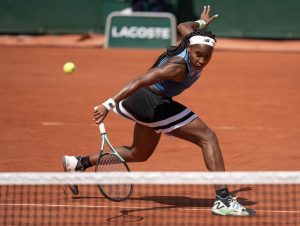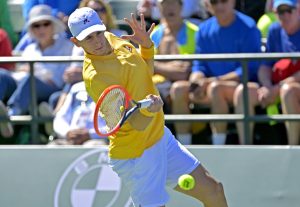Billie Jean King’s recent statement that in the future men should play three-set matches rather than five-set matches at Grand Slams is one of the rare instances when BJK, one of the finest analysts of tennis as well as one of its finest players, has got it wrong. Five-setters are the essence of tennis, or more precisely the essence of tennis greatness. And as a true tennis great herself, BJK should know that.
It was in Singapore last week that BJK publicly offered her opinion on the future of the sport and given her position as the great elder stateswoman of tennis her words were instantly reported around the world. She said, “Personally, I don’t want the men playing five sets anymore. I think it takes too much out of them.” It is undeniable that best-of-five matches are more physically demanding than best-of-three matches, but instead of solely considering what they “take out” of players, BJK should also consider what it gives them. And what it gives them is the chance to prove that they are not only outstanding technicians who have mastered the many skills required to play tennis but extraordinary athletes, whose physical stamina and astonishing conditioning are comparable with those of any other sportsmen or women.
BJK specifically cited the example of the 2012 Australian Open Final, when Novak Djokovic and Rafael Nadal fought each other to a standstill over nearly six hours, before Djokovic finally emerged triumphant. As BJK put it, “Like one time the players played in the Australian Open final. It took six hours. They could hardly walk off the court. I guarantee you that it took a year off their careers.” Even if that last statement were true (and there is obviously no way of proving it definitively), what that remarkable final gave both men was another large dose of sporting immortality.
For Djokovic, that Melbourne match-up was the culmination of the single most incredible year of his career, during which he won four out of five Grand Slams, and he ended up doing to Nadal what Nadal himself had done to Roger Federer nearly four years earlier at Wimbledon, when Nadal defeated the great Swiss in another epic, five-set final. Djokovic shattered the aura of invincibility that had grown up around Nadal, just as Nadal had done to Federer. And for Nadal, his sheer obduracy and never-say-die attitude in defeat at Melbourne in 2012 was proof that he was that rarest of sportsmen or women – one who could win with grandeur but also lose with grace.
On the men’s side of the game, almost all the great matches in tennis history have been five-setters. Indeed, it is almost a condition of greatness in tennis that a match must go to five sets in order for it to attain true greatness. Four months before their Australian Open classic, Djokovic and Nadal had gone head-to-head again in another Major Final, the 2011 US Open Final. However, although that match was absolutely superb, it fell just short of true greatness as it only lasted for four sets. For it to have matched Melbourne 2012, or Wimbledon 2008, or the McEnroe-Borg masterpiece of Wimbledon 1980, or any of the other greatest matches in tennis history, it needed to go to a deciding set.
The beauty of five-set matches is precisely that they do take a lot of time and thus have the potential to acquire epic status. As I wrote in another piece on proposals to downgrade Davis Cup matches to three-setters, one of the prerequisites of an “epic” event of any kind, sporting or artistic, is that it takes place over an extended period. As I said then, I say again now, “Anything that is truly epic both has to take time and embody the ebb and flow of time (with five-set matches allowing players to come back from disastrous starts in a way that three-set matches simply do not)”.
Proposals of this kind by BJK and others, including Chris Kermode, the head of the ATP, risk stripping tennis of that epic quality. Instead of doing that, those players and administrators–especially BJK, the woman who did so much to raise the profile of the women’s game–should be advocating that women, too, should be playing five-setters at Grand Slams. That would give them the chance to prove that they are every bit as skilled and athletic as their male counterparts. And as Matthew Syed wrote in a superb piece in The Times last summer, denying women the right to play for as long as men is actually incredibly sexist–indeed every bit as sexist as it was to deny women the right to run the longer-distance events at the Olympics, as was the case for much of the 20th century.
That is why it was so grimly ironic that BJK, of all people, should make the case for a reduction in the length of men’s matches at Grand Slams. The fact is that other than Davis Cup matches, Grand Slams are the only remaining events where men do play five-set matches. Most Masters events were played over five sets until 2007, but in 2008 all of them switched to being three-setter events. Consequently, it is now only in the Majors–the four great pinnacles of the sport–that the issue even arises.
If BJK is genuinely interested in reducing the workload for male players, it would be far better for her to throw her weight behind the campaign to revise and re-organise the tennis year, with the Australian Open moving from January to the spring and the ATP Finals moving forward a month to October. That would shorten the tennis calendar by several months and give the players a true off-season (from November to early January) for the first time ever.
At the moment, there appears to be little widespread support for BJK’s argument, but that could change in the future, and if it does the argument must be resisted even more firmly. If her proposals ever are implemented, it would effectively mean the end of tennis, or more specifically men’s tennis, as we have known it and loved it for more than a hundred years. There would no longer be any continuity with the sport’s past (five-set finals having been played since the very first Major, Wimbledon in 1877) and the great players of the future would be denied the chance to show that they are at least the equals of their predecessors, if not their betters. For that reason, we simply must keep best-of-five alive.
Main Photo:
Embed from Getty Images






